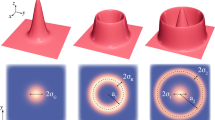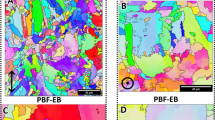Abstract
This work presents a physics-based analytical modeling methodology for the prediction of the lack-of-fusion porosity in powder bed metal additive manufacturing (PBMAM) considering the molten pool geometry, powder size variation, and packing. The presented model has promising short computational time without resorting to the finite element method or any iteration-based simulations. The temperature profiles were calculated using a closed-form temperature solution. Multiple transverse sectional areas of the molten pool geometry were plotted on a cross-sectional area of the part based on hatch space and layer thickness to calculate the lack-of-fusion area. The powder bed porosity was calculated using advancing front approach with consideration of powder statistical distribution and powder packing. The part porosity was converted from the calculated lack-of-fusion area by multiplying the calculated powder bed porosity. Acceptable agreements were observed upon validation against experimental measurements under various process conditions in PBMAM of Ti6Al4V. The computational time was recorded less than 26 s for the porosity calculation of five consecutive layers. The presented model has high prediction accuracy and high computational efficiency, which allow the porosity calculation for large-scale parts and process parameters planning through inverse analysis, and thus improves the usefulness of analytical modeling in real applications.


source and boundary heat loss from convection and radiation, respectively. P, V denote laser powder and scan velocity. W, L, D denote molten pool width, length, and depth









Similar content being viewed by others
References
D.S. Thomas, S.W. Gilbert, Costs and cost effectiveness of additive manufacturing. NIST Spec. Publ. 1176, 12 (2014). https://doi.org/10.6028/NIST.SP.1176
J.J. Lewandowski, M. Seifi, Metal additive manufacturing: a review of mechanical properties. Annu. Rev. Mater. Res. 46, 151–186 (2016). https://doi.org/10.1146/annurev-matsci-070115-032024
B. Van Hooreweder, Y. Apers, K. Lietaert, J.P. Kruth, Improving the fatigue performance of porous metallic biomaterials produced by selective laser melting. Acta Biomater. 47, 193–202 (2017). https://doi.org/10.1016/j.actbio.2016.10.005
R. Wauthle, J. Van Der Stok, S.A. Yavari, J. Van Humbeeck, J.P. Kruth, A.A. Zadpoor, H. Weinans, M. Mulier, J. Schrooten, Additively manufactured porous tantalum implants. Acta Biomater. 14, 217–225 (2015). https://doi.org/10.1016/j.actbio.2014.12.003
H. Yi, L. Qi, J. Luo, D. Zhang, N. Li, Direct fabrication of metal tubes with high-quality inner surfaces via droplet deposition over soluble cores. J. Mater. Process. Technol. 264, 145–154 (2019). https://doi.org/10.1016/j.jmatprotec.2018.09.004
H. Yi, L. Qi, J. Luo, D. Zhang, H. Li, X. Hou, Effect of the surface morphology of solidified droplet on remelting between neighboring aluminum droplets. Int. J. Mach. Tools Manuf. 130, 1–11 (2018). https://doi.org/10.1016/j.ijmachtools.2018.03.006
H. Yi, L. Qi, J. Luo, N. Li, Hole-defects in soluble core assisted aluminum droplet printing: Metallurgical mechanisms and elimination methods. Appl. Therm. Eng. 148, 1183–1193 (2019). https://doi.org/10.1016/j.applthermaleng.2018.12.013
H. Yi, L.H. Qi, J. Luo, Y. Jiang, W. Deng, Pinhole formation from liquid metal microdroplets impact on solid surfaces. Appl. Phys. Lett. 108(4), 041601 (2016). https://doi.org/10.1063/1.4940404
N.T. Aboulkhair, N.M. Everitt, I. Ashcroft, C. Tuck, Reducing porosity in AlSi10Mg parts processed by selective laser melting. Addit. Manuf. 1, 77–86 (2014). https://doi.org/10.1016/j.addma.2014.08.001
R. Li, J. Liu, Y. Shi, L. Wang, W. Jiang, Balling behavior of stainless steel and nickel powder during selective laser melting process. Int. J. Adv. Manuf. Technol. 59(9–12), 1025–1035 (2012). https://doi.org/10.1007/s00170-011-3566-1
G. Vastola, Q.X. Pei, Y.W. Zhang, Predictive model for porosity in powder-bed fusion additive manufacturing at high beam energy regime. Addit. Manuf. 22, 817–822 (2018). https://doi.org/10.1016/j.addma.2018.05.042
C. Teng, H. Gong, A. Szabo, J.J.S. Dilip, K. Ashby, S. Zhang, N. Patil, D. Pal, B. Stucker, Simulating melt pool shape and lack of fusion porosity for selective laser melting of cobalt chromium components. J. Manuf. Sci. Eng. 139(1), 011009 (2017). https://doi.org/10.1115/1.4034137
G. Kasperovich, J. Haubrich, J. Gussone, G. Requena, Correlation between porosity and processing parameters in TiAl6V4 produced by selective laser melting. Mater. Des. 105, 160–170 (2016). https://doi.org/10.1016/j.matdes.2016.05.070
J.A. Slotwinski, E.J. Garboczi, K.M. Hebenstreit, Porosity measurements and analysis for metal additive manufacturing process control. J. Res. Nat. Inst. Stand. Technol. 119, 494 (2014). https://doi.org/10.6028/jres.119.019
A.B. Spierings, M. Schneider, R. Eggenberger, Comparison of density measurement techniques for additive manufactured metallic parts. Rapid Prototyp. J. 17(5), 380–386 (2011). https://doi.org/10.1108/13552541111156504
C. Bruna-Rosso, A.G. Demir, B. Previtali, Selective laser melting finite element modeling: validation with high-speed imaging and lack of fusion defects prediction. Mater. Des. 156, 143–153 (2018). https://doi.org/10.1016/j.matdes.2018.06.037
T. Mukherjee, T. DebRoy, Mitigation of lack of fusion defects in powder bed fusion additive manufacturing. J. Manuf. Process. 36, 442–449 (2018). https://doi.org/10.1016/j.jmapro.2018.10.028
P. Wei, Z. Wei, Z. Chen, Y. He, J. Du, Thermal behavior in single track during selective laser melting of AlSi10Mg powder. Appl. Phys. A 123(9), 604 (2017). https://doi.org/10.1007/s00339-017-1194-9
Z. Chen, Y. Xiang, Z. Wei, P. Wei, B. Lu, L. Zhang, J. Du, Thermal dynamic behavior during selective laser melting of K418 superalloy: numerical simulation and experimental verification. Appl. Phys. A 124(4), 313 (2018). https://doi.org/10.1007/s00339-018-1737-8
C. Körner, E. Attar, P. Heinl, Mesoscopic simulation of selective beam melting processes. J Mater. Process. Technol. 211(6), 978–987 (2011). https://doi.org/10.1016/j.jmatprotec.2010.12.016
Y. Xiang, S. Zhang, Z. Wei, J. Li, P. Wei, Z. Chen, L. Yang, L. Jiang, Forming and defect analysis for single track scanning in selective laser melting of Ti6Al4V. Appl. Phys. A 124(10), 685 (2018). https://doi.org/10.1007/s00339-018-2056-9
J.L. Tan, C. Tang, C.H. Wong, A computational study on porosity evolution in parts produced by selective laser melting. Metall. Mater. Trans. A 49(8), 3663–3673 (2018). https://doi.org/10.1007/s11661-018-4697-x
M. Bayat, S. Mohanty, J.H. Hattel, Multiphysics modelling of lack-of-fusion voids formation and evolution in IN718 made by multi-track/multi-layer L-PBF. Int. J. Heat Mass Transf. 139, 95–114 (2019). https://doi.org/10.1016/j.ijheatmasstransfer.2019.05.003
A. AlFaify, J. Hughes, K. Ridgway, Controlling the porosity of 316L stainless steel parts manufactured via the powder bed fusion process. Rapid Prototyp. J. 25(1), 162–175 (2019). https://doi.org/10.1108/RPJ-11-2017-0226
G. Tapia, A.H. Elwany, H. Sang, Prediction of porosity in metal-based additive manufacturing using spatial Gaussian process models. Addit. Manuf. 12, 282–290 (2016). https://doi.org/10.1016/j.addma.2016.05.009
M. Khanzadeh, S. Chowdhury, M.A. Tschopp, H.R. Doude, M. Marufuzzaman, L. Bian, In-situ monitoring of melt pool images for porosity prediction in directed energy deposition processes. IISE Trans. 51(5), 437–455 (2019). https://doi.org/10.1080/24725854.2017.1417656
A. Garg, J.S.L. Lam, M.M. Savalani, A new computational intelligence approach in formulation of functional relationship of open porosity of the additive manufacturing process. Int. J. Adv. Manuf. Technol. 80(1–4), 555–565 (2015). https://doi.org/10.1007/s00170-015-6989-2
J. Ning, S.Y. Liang, A comparative study of analytical thermal models to predict the orthogonal cutting temperature of AISI 1045 steel. Int. J. Adv. Manuf. Technol. 102(9–12), 3109–3119 (2019). https://doi.org/10.1007/s00170-019-03415-9
J. Ning, V. Nguyen, Y. Huang, K.T. Hartwig, S.Y. Liang, Constitutive modeling of ultra-fine-grained titanium flow stress for machining temperature prediction. Bio-Des. Manuf. 2(3), 153–160 (2019). https://doi.org/10.1007/s42242-019-00044-9
M. Van Elsen, M. Baelmans, P. Mercelis, J.P. Kruth, Solutions for modelling moving heat sources in a semi-infinite medium and applications to laser material processing. Int. J. Heat Mass Transf. 50(23–24), 4872–4882 (2007). https://doi.org/10.1016/j.ijheatmasstransfer.2007.02.044
D. Rosenthal, The theory of moving sources of heat and its application of metal treatments. Trans. ASME 68, 849–866 (1946)
J. Ning, D.E. Sievers, H. Garmestani, S.Y. Liang, Analytical modeling of in-process temperature in powder bed additive manufacturing considering laser power absorption, latent heat, scanning strategy, and powder packing. Materials 12(5), 808 (2019). https://doi.org/10.3390/ma12050808
J. Ning, D.E. Sievers, H. Garmestani, S.Y. Liang, Analytical thermal modeling of metal additive manufacturing by heat sink solution. Materials 12(16), 2568 (2019). https://doi.org/10.3390/ma12162568
J. Ning, E. Mirkoohi, Y. Dong, D.E. Sievers, H. Garmestani, S.Y. Liang, Analytical modeling of 3D temperature distribution in selective laser melting of Ti-6Al-4V considering part boundary conditions. J. Manuf. Process. 44, 319–326 (2019). https://doi.org/10.1016/j.jmapro.2019.06.013
J. Ning, D.E. Sievers, H. Garmestani, S.Y. Liang, Analytical modeling of in-process temperature in powder feed metal additive manufacturing considering heat transfer boundary condition. J. Precis. Eng. Manuf. Green Technol. Int. (2019). https://doi.org/10.1007/s40684-019-00164-8
J. Ning, D.E. Sievers, H. Garmestani, S.Y. Liang, Analytical modeling of transient temperature in powder feed metal additive manufacturing during heating and cooling stages. Appl. Phys. A 125(8), 496 (2019). https://doi.org/10.1007/s00339-019-2782-7
M. Tang, P.C. Pistorius, J.L. Beuth, Prediction of lack-of-fusion porosity for powder bed fusion. Addit. Manuf. 14, 39–48 (2017). https://doi.org/10.1016/j.addma.2016.12.001
Y.T. Feng, K. Han, D.R.J. Owen, Filling domains with disks: an advancing front approach. Int. J. Numer. Methods Eng. 56(5), 699–713 (2003). https://doi.org/10.1002/nme.583
A.V. Gusarov, T. Laoui, L. Froyen, V.I. Titov, Contact thermal conductivity of a powder bed in selective laser sintering. Int. J. Heat Mass Transf. 46(6), 1103–1109 (2003). https://doi.org/10.1016/S0017-9310(02)00370-8
J. Ning, V. Nguyen, Y. Huang, K.T. Hartwig, S.Y. Liang, Inverse determination of Johnson-Cook model constants of ultra-fine-grained titanium based on chip formation model and iterative gradient search. Int. J. Adv. Manuf. Technol. 99(5–8), 1131–1140 (2018). https://doi.org/10.1007/s00170-018-2508-6
J. Ning, S.Y. Liang, Model-driven determination of Johnson-Cook material constants using temperature and force measurements. Int. J. Adv. Manuf. Technol. 97(1–4), 1053–1060 (2018). https://doi.org/10.1007/s00170-018-2022-x
Y. Yang, M.F. Knol, F. Van Keulen, C. Ayas, A semi-analytical thermal modelling approach for selective laser melting. Addit. Manuf. 21, 284–297 (2018). https://doi.org/10.1016/j.addma.2018.03.002
J.J.S. Dilip, S. Zhang, C. Teng, K. Zeng, C. Robinson, D. Pal, B. Stucker, Influence of processing parameters on the evolution of melt pool, porosity, and microstructures in Ti-6Al-4V alloy parts fabricated by selective laser melting. Prog. Addit. Manuf. 2(3), 157–167 (2017). https://doi.org/10.1007/s40964-017-0030-2
M.D. Abramoff, P.J. Magalhaes, S.J. Ram, Image processing with ImageJ. Biophoton. Int. 11(7), 36–42 (2004). https://imagej.nih.gov/ij/
H.W. Mindt, O. Desmaison, M. Megahed, A. Peralta, J. Neumann, Modeling of powder bed manufacturing defects. J. Mater. Eng. Perform. 27(1), 32–43 (2018). https://doi.org/10.1007/s11665-017-2874-5
I.A. Roberts, C.J. Wang, R. Esterlein, M. Stanford, D.J. Mynors, A three-dimensional finite element analysis of the temperature field during laser melting of metal powders in additive layer manufacturing. Int. J. Mach. Tools Manuf. 49(12–13), 916–923 (2009). https://doi.org/10.1016/j.ijmachtools.2009.07.004
Acknowledgments
The authors would like to acknowledge the funding support from The Boeing Company.
Author information
Authors and Affiliations
Corresponding authors
Ethics declarations
Conflict of interest
The authors declare that they have no conflict of interest.
Additional information
Publisher's Note
Springer Nature remains neutral with regard to jurisdictional claims in published maps and institutional affiliations.
Rights and permissions
About this article
Cite this article
Ning, J., Wang, W., Zamorano, B. et al. Analytical modeling of lack-of-fusion porosity in metal additive manufacturing. Appl. Phys. A 125, 797 (2019). https://doi.org/10.1007/s00339-019-3092-9
Received:
Accepted:
Published:
DOI: https://doi.org/10.1007/s00339-019-3092-9




